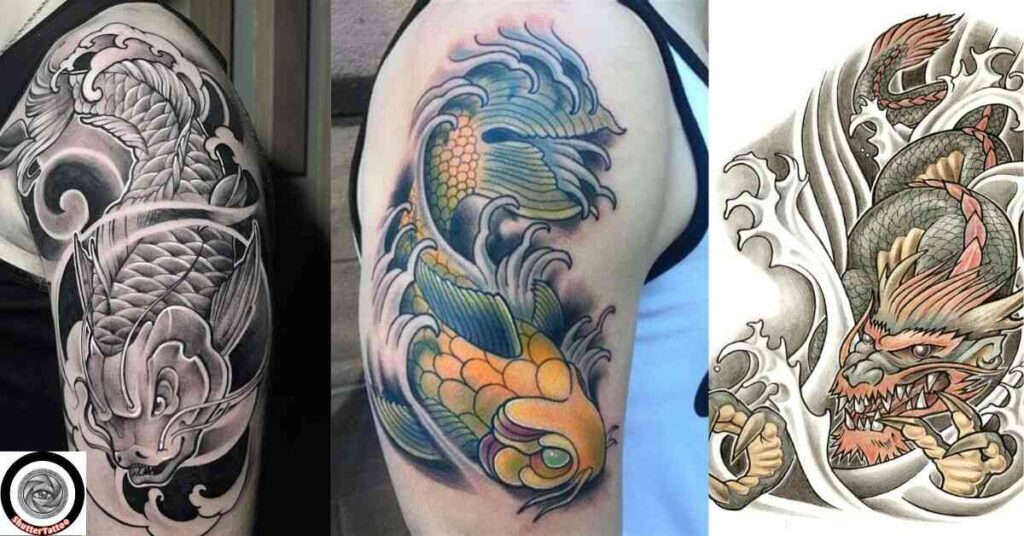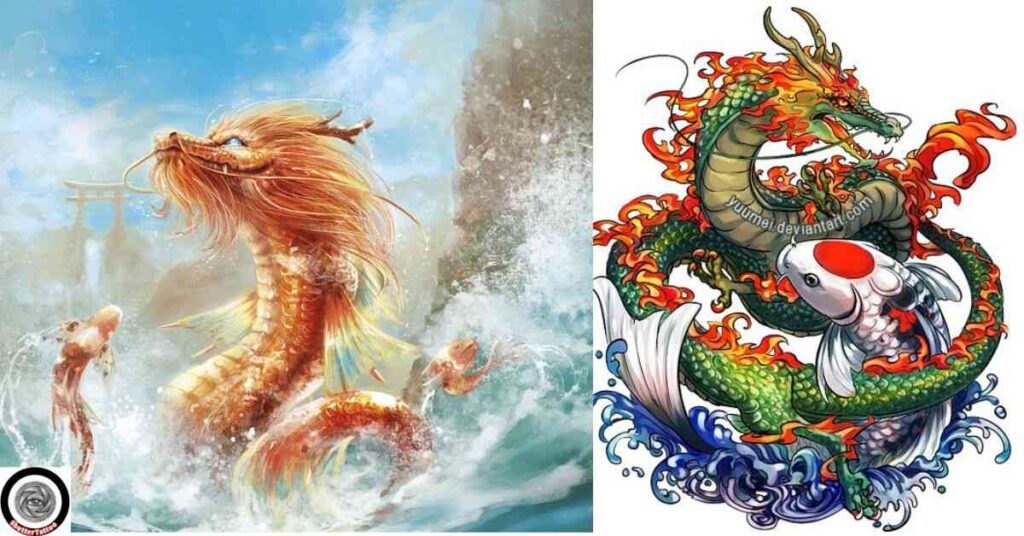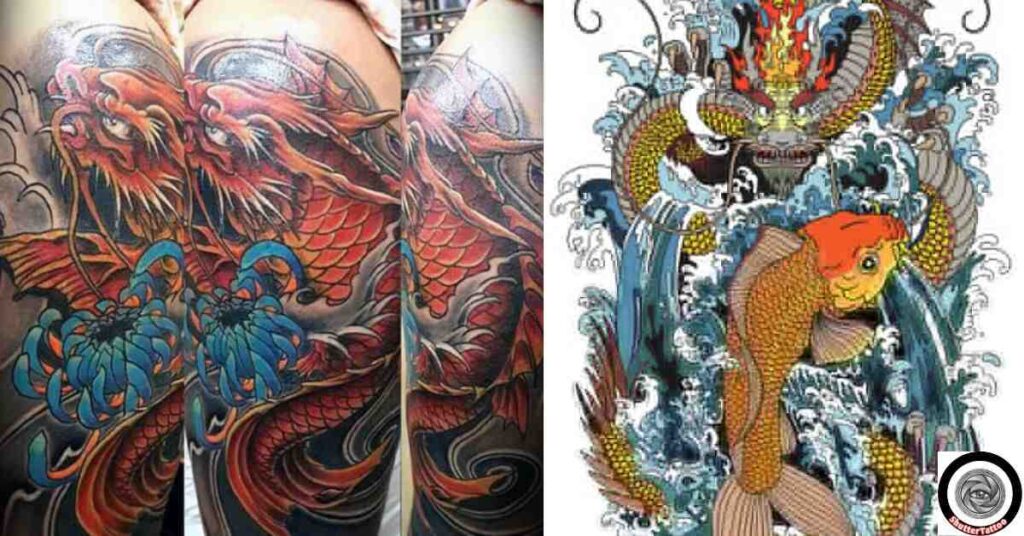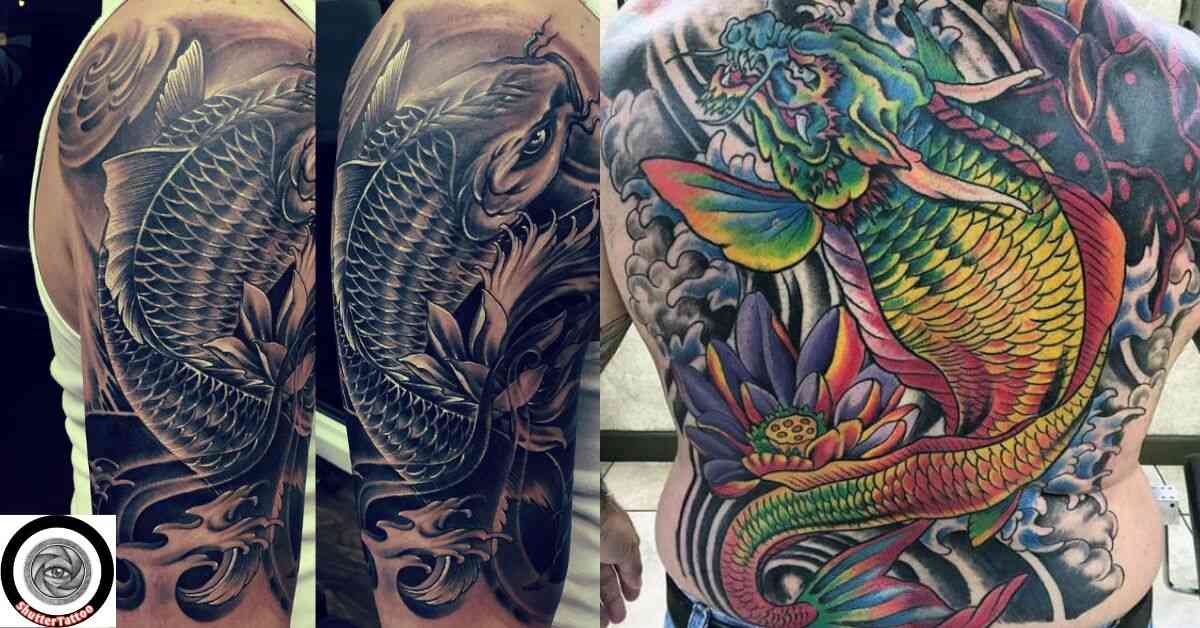A koi dragon tattoo seamlessly blends the rich symbolism of the koi fish and the dragon, creating a powerful emblem of transformation and perseverance. Rooted in East Asian mythology, this design narrates a journey of overcoming adversity to achieve greatness.
The koi’s relentless swim upstream, culminating in its metamorphosis into a majestic dragon, embodies personal growth and the triumph of determination. This tattoo serves as a visual representation of one’s resilience and unwavering pursuit of self-improvement.
Origin and Historical Background

The koi dragon motif finds its roots in ancient East Asian mythology, particularly within Chinese and Japanese cultures. According to legend, koi fish that bravely swim upstream and overcome obstacles, such as waterfalls, are rewarded by transforming into powerful dragons. This tale symbolizes perseverance and the pursuit of one’s destiny.
In traditional Japanese tattooing, known as irezumi, the koi and dragon are prominent symbols. The koi represents strength and determination, while the dragon embodies wisdom and power. Their combination in tattoo art reflects a journey of transformation and personal growth, deeply rooted in cultural narratives.
Core Symbolism of the Koi Dragon Transformation

The transformation of a koi into a dragon epitomizes the triumph over adversity. The koi’s upstream swim against strong currents signifies resilience and unwavering determination. Upon reaching the mythical Dragon Gate, the koi’s metamorphosis into a dragon illustrates the attainment of one’s goals through perseverance.
In tattoo art, this transformation is a powerful metaphor for personal evolution. It encourages individuals to embrace challenges, suggesting that enduring hardships can lead to profound personal growth and the realization of one’s potential.
Key Elements in Koi Dragon Tattoo Design

A koi dragon tattoo typically features distinct elements that narrate the transformation journey. The design often includes the koi fish, the dragon, and transitional motifs that depict the metamorphosis. Incorporating traditional Japanese artistic styles, such as flowing water and cherry blossoms, enhances the cultural significance and aesthetic appeal of the tattoo.
Color choices play a crucial role in conveying meaning. For instance, a black koi symbolizes overcoming adversity, while a red koi represents love and bravery. The dragon, often depicted with vibrant scales, embodies power and wisdom. These elements combined create a rich tapestry of symbolism, making each tattoo unique to the individual’s journey.
The Koi Phase
In the koi phase of the tattoo design, the koi fish is depicted swimming upstream, symbolizing determination and the struggle against life’s challenges. This phase represents the individual’s current state, striving for success and personal growth despite obstacles.
The Dragon Phase
The dragon phase illustrates the culmination of the koi’s journey, showcasing the transformed dragon. This symbolizes the achievement of one’s goals and the acquisition of wisdom and power. In Japanese culture, dragons are revered as benevolent beings, representing balance and good fortune.
The Transformation Stage (Ryuugyo)
The transformation stage, known as Ryuugyo, captures the pivotal moment of change from koi to dragon. This element of the tattoo embodies the process of personal evolution, highlighting the significance of perseverance and the transformative power of resilience.
Complementary Elements
Incorporating complementary elements into a koi dragon tattoo enhances its visual appeal and deepens its symbolic meaning. Traditional Japanese tattoos often feature motifs like cherry blossoms and water elements, which harmonize with the central figures of the koi and dragon. These additions not only enrich the design but also convey broader cultural narratives.
Cherry blossoms, or sakura, represent the fleeting nature of life and beauty, adding a layer of poignancy to the tattoo. Water elements, such as waves or flowing streams, symbolize life’s constant movement and the challenges one must navigate. Together, these components create a cohesive and meaningful artwork that reflects personal growth and resilience.
Cherry Blossoms
Cherry blossoms are a popular addition to koi dragon tattoos, symbolizing the transient beauty of life. Their delicate petals juxtaposed with the strength of the koi and dragon highlight the balance between fragility and power. This combination underscores the importance of appreciating life’s fleeting moments while striving for personal transformation.
Water Elements
Incorporating water elements into a koi dragon tattoo emphasizes the natural habitat of the koi fish and the fluidity of transformation. Depictions of waves or flowing water can represent life’s challenges and the individual’s journey through them. This element adds dynamism to the tattoo, illustrating movement and progress.
Modern Interpretations and Styles
Contemporary tattoo artists have reimagined the traditional koi dragon motif, blending it with modern styles to create unique designs. By incorporating elements from neo-traditional, realism, and black and grey tattoo styles, artists offer fresh perspectives on this classic symbol.
These modern adaptations allow for personalized expressions, enabling individuals to choose designs that resonate with their personal experiences and aesthetic preferences. Whether through abstract interpretations or minimalist line work, the essence of the koi dragon’s symbolism remains intact, reflecting resilience and transformation.
Contemporary Adaptations
In today’s tattoo culture, the koi dragon motif is often combined with other symbols or rendered in unconventional styles. For instance, integrating geometric patterns or watercolor techniques can provide a modern twist to the traditional design. These adaptations make the tattoo more personalized and reflective of contemporary artistic trends.
Popular Placement Options
The placement of a koi dragon tattoo significantly influences its impact and visibility. Common areas for this design include the arm, back, and chest, each offering a different canvas size and shape. The arm allows for a flowing design that can wrap around the limb, while the back provides a broad space for intricate details. The chest offers a prominent location, symbolizing the tattoo’s closeness to the heart.
Choosing the right placement depends on personal preference, the complexity of the design, and considerations regarding visibility. Consulting with a professional tattoo artist can help determine the most suitable area to achieve the desired aesthetic and symbolic effect.
Arm Placement
Placing a koi dragon tattoo on the arm allows for a dynamic design that can wrap around the bicep or forearm. This placement is versatile, accommodating both large and small designs, and offers the option to extend into a full sleeve. It’s a popular choice for those who want a balance between visibility and concealment.
Back Placement
The back provides an expansive canvas for a detailed koi dragon tattoo. This area is ideal for elaborate designs that require space to depict the full narrative of transformation. A back piece can incorporate additional elements like cherry blossoms and water, creating a comprehensive and cohesive artwork.
Chest Placement
A chest placement for a koi dragon tattoo positions the design close to the heart, symbolizing personal significance and deep connection to the tattoo’s meaning. This area allows for a prominent display of the artwork and can be extended to the shoulder or arm for a more extensive piece.
Incorporating these elements and considering placement options thoughtfully can result in a koi dragon tattoo that is not only visually striking but also rich in personal and cultural significance.
Cultural and Spiritual Significance
The koi dragon tattoo holds profound cultural and spiritual meaning, especially within Japanese traditions. Rooted in the legend of a koi fish transforming into a dragon after swimming upstream and overcoming obstacles, this motif symbolizes perseverance, transformation, and the pursuit of one’s destiny. In Japanese culture, dragons are revered as benevolent beings representing wisdom, strength, and the power to transcend the ordinary.
Incorporating this imagery into body art reflects an individual’s journey toward self-improvement and enlightenment. The tattoo serves as a reminder of the virtues of resilience and determination, encouraging the wearer to embrace challenges and strive for personal growth.
Zen Philosophy Connection
The transformation from koi to dragon resonates deeply with Zen philosophy, emphasizing inner transformation and enlightenment. This metamorphosis mirrors the Zen pursuit of transcending the ego to achieve a higher state of consciousness, highlighting the importance of perseverance and inner strength in one’s spiritual journey.
Connection to Other Japanese Deities
In Japanese mythology, dragons are often associated with deities such as Zennyo Ryūō, a rain god dragon linked to Buddhist traditions. These connections enrich the tattoo’s symbolism, intertwining themes of protection, wisdom, and spiritual guidance, and reflecting the deep cultural reverence for dragons as guardians and benefactors.
Design Considerations
When planning a koi dragon tattoo, thoughtful design choices are essential to convey personal significance and aesthetic appeal. Selecting the appropriate style, composition, and complementary elements can enhance the tattoo’s meaning and resonance with the wearer.
Incorporating traditional Japanese artistic styles, such as irezumi, can add cultural depth to the design. Additionally, elements like cherry blossoms or water motifs can symbolize the transient nature of life and the flow of experiences, respectively, enriching the overall narrative of the tattoo.
Choosing Your Design Focus
Deciding between emphasizing the koi, the dragon, or the transformation process itself is crucial. Each focus carries distinct symbolic weight: the koi represents perseverance, the dragon embodies power and wisdom, and the transformation signifies personal growth and achievement. Aligning the design focus with personal experiences and aspirations ensures the tattoo resonates deeply with the individual.
Color Selection Guide
Color choices significantly influence the symbolism of a koi dragon tattoo. For instance, a red koi embodies energy, courage, and love, while a blue koi signifies tranquility and wisdom. Incorporating gold or yellow hues can represent wealth and prosperity, aligning with the legendary transformation into a golden dragon. Selecting colors that reflect personal values and desired attributes can enhance the tattoo’s meaningfulness.
By carefully considering these design elements, individuals can create a koi dragon tattoo that not only showcases artistic beauty but also embodies profound personal and cultural significance.
FAQ
What does a Koi Dragon tattoo symbolize?
A Koi Dragon tattoo represents transformation, perseverance, and personal growth, inspired by the legend of a koi fish becoming a dragon.
What is the origin of the Koi Dragon tattoo?
The Koi Dragon tattoo originates from an ancient Chinese legend where a koi fish swims upstream and transforms into a dragon, symbolizing determination and success.
What are common design elements in Koi Dragon tattoos?
Common elements include the koi fish, dragon features, water, and cherry blossoms, each adding layers of meaning to the tattoo.
How should I choose colors for a Koi Dragon tattoo?
Color choices can reflect personal significance; for example, red may symbolize strength, while blue can represent tranquility.
Where is the best placement for a Koi Dragon tattoo?
Placement depends on personal preference and design size; common areas include the arm, back, or leg.
Conclusion
Koi Dragon tattoos are rich in symbolism, representing transformation and resilience. Originating from ancient legends, they combine elements like koi fish and dragons to tell a story of personal growth. When considering such a tattoo, think about the design elements, colors, and placement that best reflect your journey and aspirations.
Consulting with a skilled tattoo artist can help bring your vision to life, ensuring the tattoo resonates with your personal meaning and aesthetic preferences.

